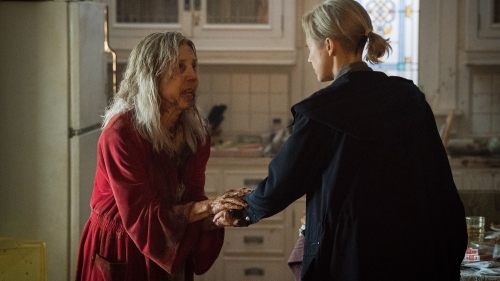DRAG ME TO HELL At 10: Goopy, Gross, And Gleeful
Spoilers for Drag Me To Hell, I guess, if for some reason you haven't seen this gem.
If you’ll allow me to borrow a tired cliché, they sure don’t make ‘em like they used to. I know, I know, this sentiment is usually founded on the idea that you “can’t” do certain things in films anymore – regardless of whether we should – but there are some aspects of previous eras of cinema where the impulse for nostalgia isn’t inherently toxic. Take, for instance, the ways in which we’ve changed our approach to visual effects in modern blockbusters. Digital effects grow exponentially more realistic with every passing year, and on the whole they’re easier to use over practical effects that require a lot of set-up and clean-up on the day of shooting. But there’s something lost in the translation, for as realistic as digital effects have become, we’re also better able to pick up on their uncanny discrepancies from reality the more we become acclimated to them, and the juxtaposition of real actors reacting to a virtual nothing can often feel out of step with the visceral enjoyment of the scene.
We were already well on our way in the trend toward over-reliance on CGI even ten years ago, but acclaimed director Sam Raimi still managed to put out a film that leaned into being a throwback, of relying on effects that weren’t there to completely upend your suspension of disbelief, but were expressions of sadistic revelry in the gross and macabre. I’m speaking, of course, of 2009’s Drag Me To Hell.
Drag Me To Hell is almost a modern folk tale in its narrative simplicity. Christine Brown (Alison Lohman), a loan officer gunning for a big promotion at her bank, denies Sylvia Ganush (Lorna Raver), an old Romani woman, an extension on her mortgage, pinning the blame on her manager while actually making the callus decision that would elevate her career. Mrs. Ganush begs on her knees, and upon being denied at this extremity, she attacks Christine, later stalking her to the parking garage and placing a curse upon her. Suddenly Christine finds herself haunted by a spirit known as a lamia and must find a way to break the curse.
This plot is a nostalgia trip in its own right to B-film shlock horror that didn’t need a higher concept than what was necessary for the exploitative spectacle it advertised, right on down to the less-than-sensitive stereotyping of Romani culture. But like those B-films, the value is in seeing that spectacle, which Raimi delivers on a studio budget as a love letter to the goofy and gross.
It starts simply, with Mrs. Ganush’s overgrown browning fingernails rapping on Christine’s desk as she unapologetically plays with her rotting dentures to the sickening smacks of saliva on the soundtrack. But then, upon that confrontation in the parking lot, Mrs. Ganush cranks her disturbing presence up a notch, taking multiple staples to the face, toothlessly slobbering all over Christine’s chin as they wrestle, and, my personal favorite, taking a ruler to the open esophagus and spitting it back out as a projectile. It’s silly, it’s absurd, and most importantly, it’s just fun.
Once the lamia starts haunting Christine, Raimi gets to show off some of his more classical horror moves, relying on darting camera movements and quick cuts to sell us on the frantic destruction of an invisible force in Christine’s home. The goat-like shadow of the lamia is a digital effect, as are many of Christine’s possessions that fly through the air in some of the more gravity-defying shots, but these effects are largely supplemental to the harsh impacts of a stuntperson being thrown into furniture or a hallucinatory satanic smash cut lurching you from a moment of artificial calm.
From here the film just becomes a collection of setpieces that continually top each other, shifting back and forth between ghostly encounters with a recently deceased Mrs. Ganush and the vengeful spirit of the lamia. A fly crawls over Christine’s face and the camera lens as the camera playfully teases which orifice the insect will crawl into next, only for Christine to awake jarringly to Mrs. Ganush laying beside her in bed, primed to pin her down and vomit maggots into her face. Christine goes to work the next day only to projectile spray blood from her nose all over her boss, who asks in a panic whether he got any in his mouth. Christine finds herself at Mrs. Ganush’s wake after attempting to pay her a visit, only to have the corpse grab her by the hair and vomit into her mouth.
With this escalation, the film becomes more cartoonish, winking more and more knowingly to the audience that what we’re seeing is completely bonkers but completely invested in towing that line between absurdist spectacle and funhouse fright. The effects aren’t meant to trick us into thinking they are grounded expressions of genuine terror but are instead more akin to a series of Halloween pranks. This becomes especially apparent when Christine thinks she’s rid herself of the lamia, only to go full comedy-of-errors in a visit to her boyfriend’s rich parents where she overreacts to a bleeding, squealing eyeball that only she can see in her fly-infested cake. Later, the ghost of Mrs. Ganush shoves her arm to the elbow down Christine’s throat, to which Christine responds in true Looney Tunes fashion by literally dropping an anvil on her head, sending eyeballs and gore directly into Christine’s screaming face. Just as absurd is a later ritual to attempt to banish the lamia that ends up involving a talking goat puppet, a possessed man doing a jig in midair, and that man vomiting up Christine’s dead kitten whole.
I’ve only had to list these increasingly absurd moments to make my point that this film is fun and silly as hell, and because it’s Sam Raimi, you know that these horror-comedy beats are going to play for simultaneous shock and laughter. Drag Me To Hell is a simple movie, but it’s one that pays willing homage to a relic of cinematic experience. Many of the effects, practical as most of them are, don’t hold up to a ton of photorealistic scrutiny, but to invest in the reality of the film as if it’s the reality in which we live is to miss the entire point. What Sam Raimi understands is that horror films can act as an escape from reality, as an absurdist dreamscape where curses and demons are real and like to have gross, goopy fun at our expense. And if you’re going to commit to making that kind of cartoon carnival ride through your theatrical haunted house, you might as well make a real mess while you’re doing it.



